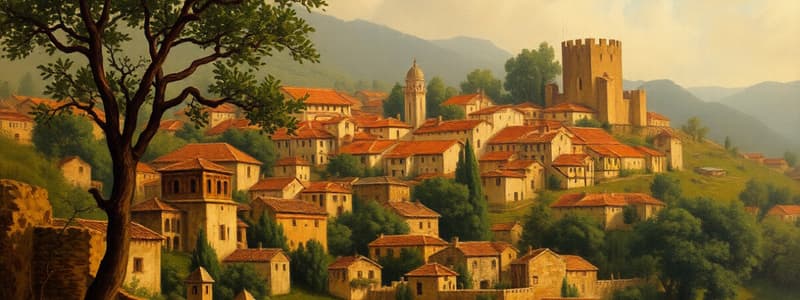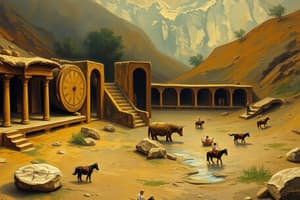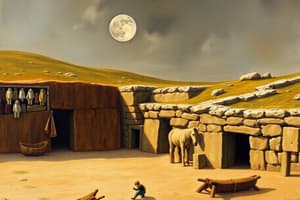Podcast
Questions and Answers
Catal Huyuk was built in a dry, desert climate.
Catal Huyuk was built in a dry, desert climate.
False (B)
What was the primary purpose of the wall surrounding Catal Huyuk?
What was the primary purpose of the wall surrounding Catal Huyuk?
Protection from intruders.
The inhabitants of Catal Huyuk moved around the village using ______ to connect the rooftops of their houses.
The inhabitants of Catal Huyuk moved around the village using ______ to connect the rooftops of their houses.
ladders
Match the features of Catal Huyuk with their descriptions:
Match the features of Catal Huyuk with their descriptions:
Which of these statements accurately describes the layout of Catal Huyuk?
Which of these statements accurately describes the layout of Catal Huyuk?
Flashcards
Catal Huyuk Village
Catal Huyuk Village
One of the first complex villages established around 8,000 years ago.
Population of Catal Huyuk
Population of Catal Huyuk
The village had a population of approximately 5,000 people.
Village Layout
Village Layout
Clusters of square or rectangular houses, connected by ladders on rooftops.
Religious Shrines
Religious Shrines
Signup and view all the flashcards
Protection Features
Protection Features
Signup and view all the flashcards
Study Notes
Catal Huyuk Village
- The Catal Huyuk village was one of the first complex villages, established approximately 8,000 years ago.
- The population was 5,000 people.
- The village was located near water for irrigation.
- Houses were built in clusters and were rectangular or square.
- The houses were made of bricks.
- Religious shrines were larger and could accommodate hundreds of people.
- The buildings were very close together creating a wall around the village.
- People used connecting rooftops.
- Fires were common, with smoke visible from the surrounding area.
- Domesticated animals were housed inside and outside the village.
Advanced Cities
- People specialized in crafts like pottery, cloth making, farming, and carpentry.
- People could enlist the assistance of a military leader to settle disputes.
Studying That Suits You
Use AI to generate personalized quizzes and flashcards to suit your learning preferences.




